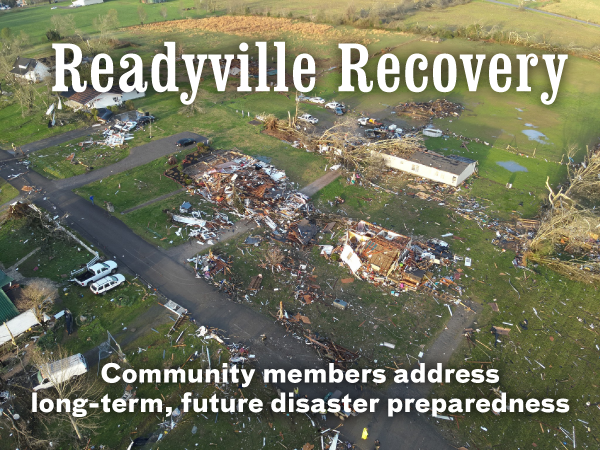
On the night of March 31, the residents of the Readyville area were awakened by warnings of an EF2 tornado touchdown. The aftermath was devastating. Though they suffered no casualties, many of these residents found their lives upended when the sun rose April 1.
Historical landmarks, homes and property had been destroyed; however, in the wake of the disaster, the surrounding communities in Rutherford and Cannon County came together to help their neighbors rebuild. The outpouring of love was incredible and unprecedented, though as time wore on, many property owners were still dealing with property damage that had been put on the back burner in the name of more pressing repairs. The folks of Readyville had to get back to their lives and their jobs.
Some Rutherford County residents realized the need for a long-term recovery effort for the community, and the need for the area to be better prepared for future disasters, and began the process of forming a long-term recovery group specific to the Readyville event, and, eventually, a VOAD committee.
A VOAD (Voluntary Organization Active in Disasters) is a committee run by local citizens designed to facilitate community action in its area should any disasters occur in the future. Representatives from Rutherford County EMS, local churches, FEMA (Department of Human Services), Greenhouse Ministries, and even the Rutherford Library System attended an initial meeting at the Advent Lutheran Church in June.
They discussed the parameters that would be required for the Rutherford County Long Term Recovery Group and a VOAD to be put in place and the objectives that having a local volunteer-run disaster relief program could accomplish and began identifying individuals who could serve on a board of directors for the group.
“A regional or local Volunteer Organization Active in Disaster would be something that exists in the blue skies and in the gray skies when you’re responding to a disaster. It’s a group of organizations that come together to help a community be prepared for and respond to disasters,” remarked Robert Craig, the disaster response coordinator for the Tennessee/Western Kentucky Conference of the United Methodist Church when differentiating between the purpose of a VOAD versus a long-term recovery group. “A long-term recovery group might be deployed for a specific disaster, but a VOAD—that would be something that’s year-round to help the community be ready. A long-term recovery group stands up only for a specific disaster for a short period of time and would then fade away until or unless it’s needed again.”
Subsequent meetings were held to continue fleshing out the local recovery group and the mission of helping the community to be better prepared whenever the next storm hits.
Meanwhile, FEMA continues to provide funds to those in the area affected by the storms.
“The one thing we all have to remember is loss, whether it’s what you consider a big loss—it’s still loss. You know, people whose things don’t mean a hill of beans to anybody but them . . . you might lose your baby’s christening gown or your wedding ring,” according to FEMA representative Yvonne Antoine-Wilson, encouraging those with losses resulting from disasters to make contact for assistance. “We’ve got to remember loss to people is loss. And this committee is forming to help assist people in loss. We try our best to get them back to a situation that’s a new normal.”
Those with needs resulting from disaster can contact FEMA at 800-621-3362.













